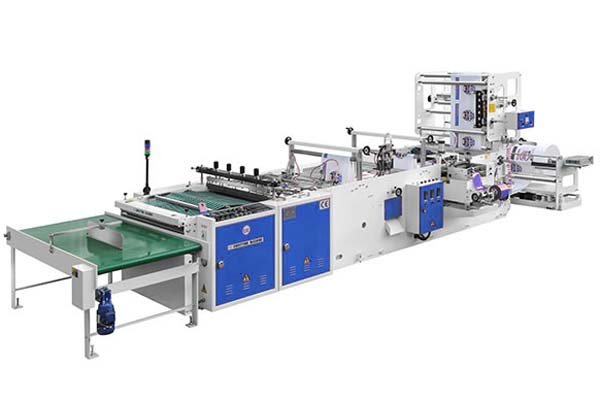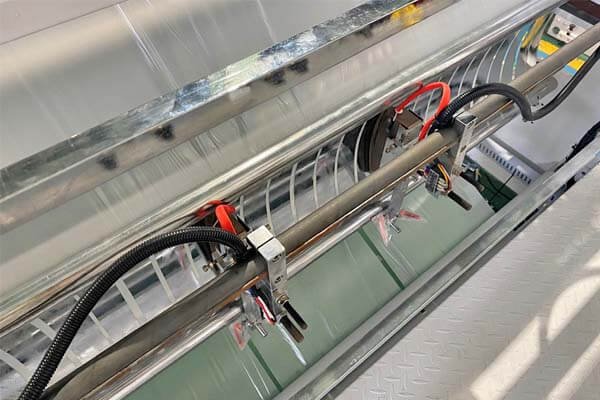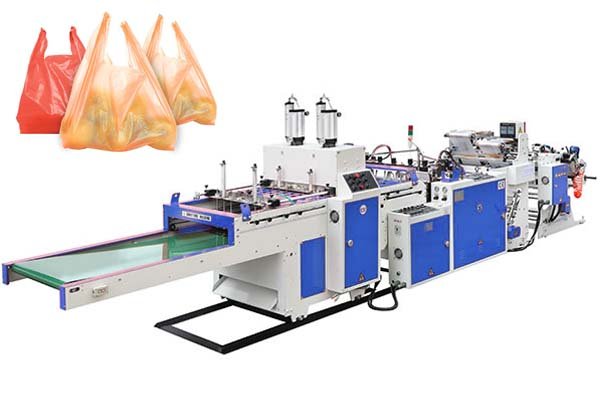
Choosing the appropriate handle system for plastic bags can significantly influence production efficiency, branding, and customer satisfaction. This guide outlines the key distinctions between patch handle and loop handle bags to support an informed decision.
Patch handles1 are die-cut handles reinforced with a sealed patch, offering a streamlined appearance. Loop handles2, by contrast, are externally welded, soft loops that provide added strength and a premium user experience.
The type of handle determines the necessary machinery and impacts manufacturing methods3. A patch handle bag is made by sealing a reinforcing film onto the bag before die-cutting the handle. A loop handle bag is created by forming the bag body first, then attaching a separate loop. These different workflows affect equipment costs4, speed, and final bag aesthetics.
BagMec® manufactures both machine types and supports businesses in aligning their packaging solutions with brand and operational goals. High-volume, cost-sensitive operations may prefer patch handles, while premium retailers often choose loop handles to enhance brand presentation and durability5.
Production Workflow Comparison: Patch vs. Loop Handle Machines
The manufacturing processes for patch and loop handle bags involve distinct technologies. Understanding these can help businesses evaluate equipment investment and output capacity.
Patch handle machines include a built-in unit to apply a reinforcing patch before the die-cutting phase. Loop handle machines use a separate unit to form, transport, and weld the loop onto the bag exterior.

Patch Handle Process
Patch handle production follows a consistent, integrated sequence:
- Film Feeding: The main film roll is fed into the machine with automated tension control.
- Patch Application: A separate patch film is applied using a heated sealing bar.
- Folding & Sealing: The film is folded, and side seams are sealed.
- Die-Cutting: A handle shape is punched through the reinforced patch area.
Loop Handle Process
Loop handle production involves a more segmented mechanical system:
- Bag Body Formation: The machine forms and seals the main bag structure.
- Loop Creation: A separate film is processed into loops by cutting, folding, and sealing.
- Handle Placement: A transport mechanism positions loops onto the bag.
- Welding: Heat welds the handles to the bag surface with precise alignment.
Equipment and Footprint Overview
| Feature | Patch Handle Machine | Loop Handle Machine |
|---|---|---|
| Core Unit | Integrated patch applicator and die-cutter | Loop forming and welding unit |
| Size | Compact | Larger footprint |
| Speed | Up to 1,200 bags/hour | 800–1,000 bags/hour |
| Inputs | Film roll + patch film | Film roll + loop film |
| System Complexity | Simpler design | More moving parts |
Handle Type Impact on Cost and ROI
Selecting a handle system also impacts financial planning, including machine cost and long-term return on investment6 (ROI).
Patch handle machines are lower-cost, typically between $8,500–$15,500. Loop handle machines require higher upfront investment, usually $33,000–$38,000, but can generate higher ROI for brands focused on product value.

Machine Price Breakdown
- Patch Handle Machine ($8,500–$15,500): Suitable for startups or high-volume, cost-sensitive applications.
- Loop Handle Machine ($33,000–$38,000): Justified by the complexity and added branding value, ideal for premium sectors.
Operational and Material Considerations
| Factor | Patch Handle | Loop Handle |
|---|---|---|
| Material | Main film + small patch | Main film + thicker loop film |
| Energy Use | Lower (with servo motors) | Slightly higher due to loop unit |
| Maintenance | Simpler; fewer parts | More calibration required |
| Labor Needs | Minimal oversight | Skilled monitoring recommended |
ROI Models
- Patch Handle Machines: ROI is driven by volume. Ideal for mass-market or promotional use where unit cost matters most.
- Loop Handle Machines: ROI is driven by value. Adds to product appeal, suitable for premium brands seeking stronger packaging and customer satisfaction7.
A BagMec® customer in India, Priya Kapoor, reported fewer returns after adopting loop handle bags, resulting in improved ROI for her logistics business.
Industry Preferences for Handle Types
Handle choice often reflects the target market’s priorities. Each style aligns with different industry needs.
Patch handles1 dominate in retail and promotional sectors due to their speed and cost-efficiency. Loop handles2 are preferred in fashion and premium retail environments where presentation and strength are vital.
Industries Favoring Patch Handles
- Supermarkets: High throughput with minimal cost.
- Trade Shows/Events: Ideal for giveaways with printed logos.
- Pharmacies/Small Retail: Professional look for light items.
Industries Favoring Loop Handles
- Luxury Fashion/Boutiques: Packaging reflects brand image.
- Department Stores: Suitable for heavier or larger goods.
- Gift Shops: Aesthetic value enhances gift presentation.
Quick Reference Guide
| Industry | Primary Need | Recommended Handle | Rationale |
|---|---|---|---|
| Supermarkets | Cost & speed | Patch Handle | Efficient and scalable |
| Luxury Retail | Brand appeal | Loop Handle | Enhances perceived value |
| Shoe Stores | Strength | Loop Handle | Supports heavier items |
| Trade Shows | Branding | Patch Handle | Budget-friendly advertising |
| Electronics | Durability | Loop Handle | Secures valuable goods |
Customization Options for Both Handle Types
Customization enhances branding potential for both handle styles. Each offers unique options in material, design, and print.
Patch handles allow for die-cut shapes and patch colors. Loop handles offer a broader range of handle materials, colors, and textures. Both support full-surface printing.

Patch Handle Customization
- Patch Color: Contrasting or branded color schemes.
- Handle Shape: Custom die-cuts based on logos or design.
- Print Placement: Applied pre-cutting for precise branding.
A German food company used green patches to align with their logo, improving shelf visibility.
Loop Handle Customization
- Loop Material & Color: Vary material thickness and texture.
- Bag Gussets: Add volume for bulky goods; machine-configurable.
- Full-Bleed Printing: Continuous graphic design across the bag.
BagMec® Customization Process
- Consultation: Understand needs and goals.
- Engineering: Tailor machine specs to handle type and features.
- Manufacturing: Built with high-grade materials in ISO-certified facilities.
- Testing: 72-hour performance test using client-specific film.
Conclusion
Choosing between a patch or loop handle depends on production goals, customer expectations, and brand positioning.
Patch handles are cost-effective and suited for high-volume production. Loop handles offer a more premium experience with added strength and visual appeal. BagMec® offers tailored solutions for both systems to support business success.
-
Explore how Patch handles can enhance production efficiency and branding for your business. ↩ ↩
-
Discover the premium user experience and strength Loop handles offer for retail packaging. ↩ ↩
-
Get insights into the distinct manufacturing processes for each handle type. ↩
-
Explore the financial implications of choosing between patch and loop handle machinery. ↩
-
Explore the features that make loop handle bags more durable for various applications. ↩
-
Evaluate the long-term financial benefits of each handle type for your business. ↩
-
Find out how handle design can improve customer experience and satisfaction. ↩






